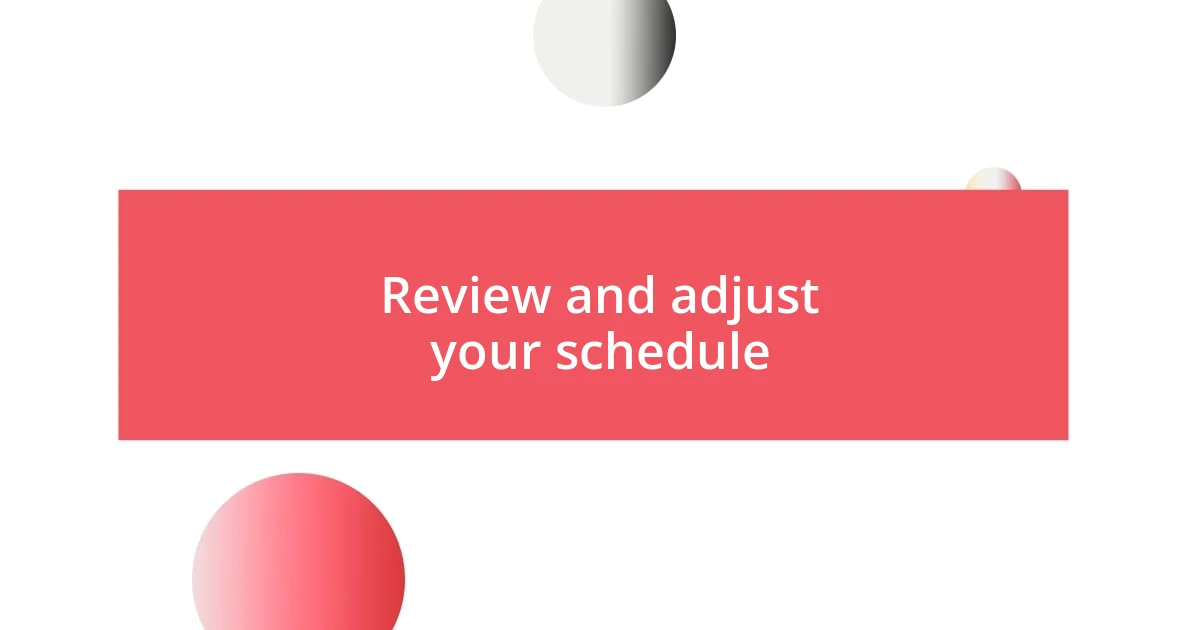Key takeaways:
- Track and analyze time usage to identify non-productive habits and peak productivity hours.
- Set SMART goals and regularly review them to maintain focus and accountability in achieving tasks.
- Minimize distractions and adjust plans flexibly to enhance productivity and adapt to changing circumstances.

Understand your time usage
Understanding how I spend my time has been a game changer for me. A few years ago, I started tracking my daily activities in a simple journal. It surprised me to see that I was spending over two hours each day mindlessly scrolling through social media, a habit that didn’t add value to my life. What’s taking up your time without you even realizing it?
As I continued to analyze my time usage, I noticed patterns that I hadn’t before. For instance, I found that my most productive hours were early in the morning. I began scheduling my most challenging tasks during that time, leading to a noticeable improvement in my effectiveness. Have you thought about when you’re at your best?
One powerful insight I gained is the importance of saying no. I used to fill my calendar with commitments that drained my energy. Once I recognized how those obligations affected my time and sanity, I felt empowered to prioritize what truly mattered to me. Have you identified the areas in your life where you can reclaim your time?

Set clear goals
Setting clear goals is a fundamental aspect of effective time management. In my journey, I discovered that having specific, measurable, achievable, relevant, and time-bound (SMART) goals helps me stay focused. When I first implemented SMART goals, I noticed that my productivity soared as I developed a greater sense of direction. Have you experienced that same boost of motivation when you clearly outline what you want to achieve?
Reflecting on my experiences, I remember a time when I was overwhelmed by a long to-do list without clear priorities. One day, I decided to take a step back and establish my goals for the week. This simple act transformed my workload into manageable tasks that not only felt more attainable but also allowed me to enjoy the small wins along the way. How do you break down your goals into actionable steps?
I’ve learned that writing down my goals and revisiting them regularly is crucial for accountability. It’s easy to lose sight of what’s important if goals remain just thoughts in my head. I often take a moment each week to review my progress and adjust as needed. This practice helps me maintain clarity and keep the momentum going. What steps do you take to ensure your goals stay at the forefront of your mind?
| Type of Goal | Description |
|---|---|
| Short-term | Goals that are achievable within a few days or weeks. |
| Long-term | Goals that require a year or more to achieve, often requiring multiple short-term goals to get there. |

Prioritize your tasks effectively

Prioritize your tasks effectively
Prioritizing tasks isn’t just about checking items off a list; it’s about understanding what truly drives value in my life and work. I remember feeling overwhelmed by a myriad of tasks, but the turning point came when I started using the Eisenhower Matrix. This simple tool helped me distinguish between what’s urgent and what’s important. When I realized that not everything demanding my attention was critical, it felt liberating. How do you decide what deserves your time and energy?
- Make a list of your tasks.
- Categorize each task as urgent and important, important but not urgent, urgent but not important, or neither.
- Focus on completing the important tasks first, as they align with your long-term goals.
- Review and adjust your priorities regularly to stay on track.
By actively reflecting on my priorities, I cultivated a sense of control over my day. Establishing boundaries around my time and tasks has led to more fulfilling work and reduced stress. What methods do you have in place to keep your priorities clear and actionable?

Create a realistic schedule
Creating a realistic schedule has been one of the foundations of my time management journey. I remember when I first tried to cram too many tasks into one day; it was a recipe for disappointment and frustration. Now, I take a more thoughtful approach, considering my energy levels and commitments before committing to my schedule. Have you ever realized that some days just don’t allow for heavy lifting?
I’ve found that breaking my day into manageable blocks helps me stay focused and less overwhelmed. For instance, I often allocate specific hours for deep work, ensuring I don’t load my brain with back-to-back meetings. This has allowed me to concentrate fully on the tasks at hand while providing necessary breaks for my mind. What practices do you use to keep your schedule flexible yet structured?
Transparency with myself is key. I consciously leave room for unexpected tasks or the inevitable distractions that life throws my way. When I reflect on a week when I adhered to a realistic schedule, I can honestly say it felt like I was in flow rather than fighting the tide. Embracing this flexibility not only enhances productivity but also reduces stress. How do you ensure your schedule accommodates both commitments and spontaneity?

Use time management tools
Using time management tools can truly be a game-changer. For me, digital apps like Todoist and Trello have transformed the way I organize my tasks. I vividly recall how I once struggled with sticky notes scattered around my desk, leading to chaos. When I started using Trello, it was like switching from a frantic scribble to a smooth symphony of productivity. Have you ever felt overwhelmed trying to keep track of everything? Time tracking tools can provide a clear lens through which to view your workload.
In my experience, visualizing tasks has made a significant difference. I often color-code projects based on deadlines or complexity, allowing me to prioritize effectively. This simple practice has helped me identify bottlenecks in my workflow. There’s something incredibly satisfying about dragging a completed task to the “done” column—it’s as if I’m physically manifesting my progress. How do you visualize your tasks?
It’s equally important to find a tool that adapts to your style. I love using the Pomodoro Technique within my time management software. Setting a timer for focused work followed by short breaks keeps me energized and focused. Sometimes, I catch myself smiling while taking those breaks, feeling like I’ve just completed a sprint. Have you ever noticed how small victories throughout the day can uplift your mood? Exploring various tools until you find the right fit may take time, but it’s worth the investment in your productivity journey.

Minimize distractions
Minimizing distractions can be a transformative practice in enhancing productivity. I remember vividly when I embarked on a no-phone challenge during certain hours of my workday. It felt strange at first, almost like losing a part of my routine, but I quickly noticed how much deeper my focus became. Have you ever tried putting your phone in another room just to see how much more you could accomplish?
Creating a distraction-free workspace has also made a world of difference for me. I invested in noise-canceling headphones, which have become my best friends during intense work sessions. When I put them on, it’s like stepping into my own little cocoon of concentration. I often wonder if this quietness gives my brain the breathing space it needs to recover and generate new ideas. What methods do you use to create your ideal work environment?
Moreover, prioritizing my tasks helps in limiting distractions. On days when I’m clear about my top three priorities, I find that I’m less likely to be sidetracked by less important notifications or thoughts that pop into my head. It’s fascinating how clarity can serve as a shield against distractions. I often ask myself: “Is this task essential for today?” If the answer is no, I seamlessly push it aside. There’s something empowering about taking control of my attention, wouldn’t you agree?

Review and adjust regularly
Regularly reviewing and adjusting your time management strategies is crucial for sustained productivity. I recall a time when I would plan my week on Sunday evenings, but I rarely revisited that plan as the week unfolded. When I finally started taking a few minutes each day to assess my progress, it was eye-opening. Have you ever been surprised by how much an hour of reflection can reveal?
I’ve found that adjusting my plan based on what actually gets done—not just what I hoped to accomplish—makes all the difference. For example, I track whether tasks take longer than expected or if particular projects generate more enthusiasm than others. This insight has led me to reshuffle my workload and focus on more engaging tasks first, creating a fresh energy for the day ahead. It’s a little like tuning a musical instrument; without that adjustment, your performance can fall flat.
Moreover, I’ve learned the importance of flexibility in my schedule. If something unexpected comes up, instead of feeling frustrated, I take a moment to reassess. This shift in perspective allows me to adapt rather than get bogged down by a rigid plan. Have you noticed how being adaptable can lead to unexpected breakthroughs? Embracing this approach can transform how you perceive challenges and opportunities in your day-to-day life.















